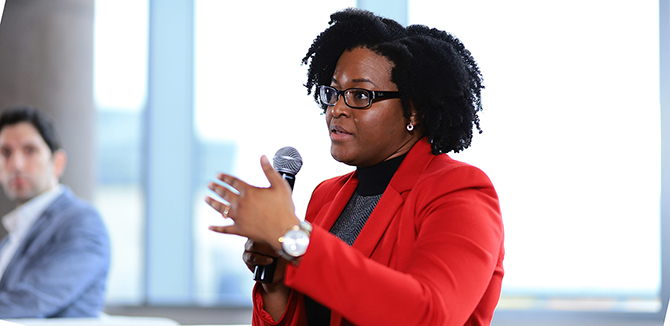Four Tips For Better ‘Relationshipping’
AbbVie Marketing Manager Stephanie Pulliam shared her advice on how students can enhance their networks before — and after — graduation.

For some people, the idea of networking can be intimidating. Stephanie Pulliam is not one of those people.
Pulliam, marketing manager for new product planning at AbbVie, embraces the idea of learning from others and expanding her network. In her eyes, networking really is "relationshipping," an idea she first learned from her MBA advisors at Auburn University. That word does not appear in dictionaries, but Pulliam believes it is an essential skill necessary to stand out in a crowded job market.
Rather than focusing on how she can benefit by knowing someone, Pulliam intentionally tries to develop relationships with other people. She wants to get to know them and learn about their experiences. Some of these relationships may be strategic, but others can happen organically.
Pulliam talked about the idea of "relationshipping" at Biotech Nexus, an annual event for students and industry leaders hosted by Northwestern’s Master of Biotechnology Program (MBP). She explained that events like Biotech Nexus provide a fertile ground to start or expand "relationshipping".
As part of the conversation, she shared four tips with students about how to effectively build relationships as they develop their careers.
Tip 1: Start early
Pulliam told students to begin building relationships with classmates and professional friends while they’re still in the program. Authentic "relationshipping" takes time, she said, and it needs to be built on more than just turning to someone in a position of authority when you need something from them.
Tip 2: Look to the head of the class
An effective way for students to start "relationshipping" is to look at the front of their classrooms and see their professors for who they are – experienced professionals with interesting stories to share.
“Go up to a professor whose background you think is pretty neat and engage in a conversation,” she said.
Tip 3: Social-ize
Many people see LinkedIn merely as a tool to share career accomplishments or find a new job; Pulliam thinks of it as the Disney World of "relationshipping".
“LinkedIn is magic,” she said. “It’s an opportunity to see people’s background. Type up a few words and say ‘Hey, your background looks great. I want to know about your journey. Do you have a quick 15-to-30 minutes to chat?’”
Part of the reason to do this is, yes, to gather insights for career development, but it’s more than that, Pulliam said.
“The more you have these engagements," she said, "the more comfortable you’ll become chatting with absolute strangers."
Tip No. 4: Be cross-functional
"Relationshipping" with people inside your group of connections often isn’t a challenge. The key, Pulliam said, is being able to build quality relationships with people in other areas outside of your comfort zone. When you're working professionally, that means building rapport with people outside of your own team or department.
If your work is science based, you shouldn’t just be talking with other science-focused professionals, she said. Instead, get to know colleagues in accounting or sales or production. Each of these opportunities allows you to develop new connections that could ultimately move a project forward, or perhaps even be beneficial later on in your career.

